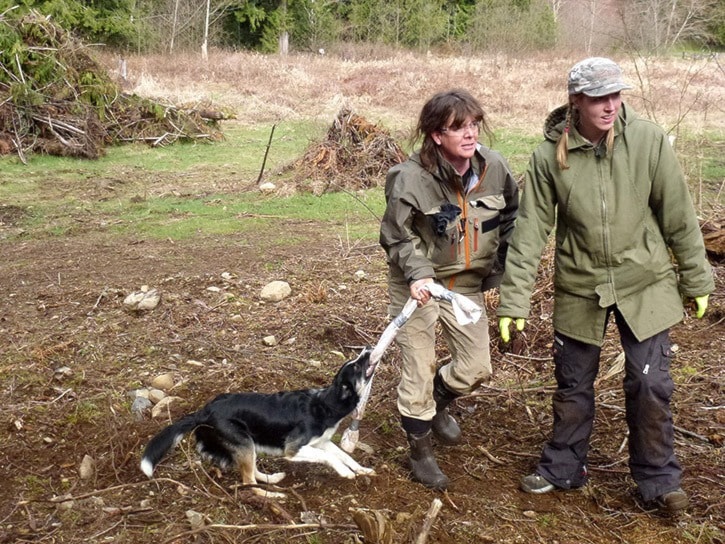Last week, a group of 25 big-hearted people who love being in the bush with their dogs came out to Cultus Lake for search and track training. The three-day program allowed handlers to certify or re-certify their dogs, as well as to assess puppies.
The entirely volunteer-run B. C. Search Dog Association held its annual meeting at Stillwood Camp from March 20-24 to train dogs for search and rescue missions throughout the province. Volunteers are also members of local ground search and rescue (SAR) teams, and some dog teams do avalanche rescues for the Canadian Avalanche Rescue Dog Association.
Chris Smith, president of BCSDA, has had his golden retriever Solo on SAR missions in Comox Valley for two years. When Smith retired from full-time air force duty, he wanted to use his military skills and his beloved family pet for community service. Recently, Solo successfully found an elderly mushroom picker on Vancouver Island, who had gotten disoriented. His wife was waiting in the car by the highway, and when her husband was hours late returning, she called the RCMP, who in turn called BCSDA.
Every spring, BCSDA members come from all corners of the province to Stillwood Camp to train dogs for searching and tracking, assess puppies, and validate dog teams. Last week, there was also some obedience training, and a one day classroom session on training philosophy for new handlers. Some years, trainers may run through scenarios in which a dog would need to commute to the search area. For this, BCSDA might bring in a boat or a helicopter so that the dog becomes accustomed to it.
Last week's event included 10 new dog handlers, who brought their puppies to run through basic training and see if the puppies could develop into search dogs.
"Some dogs have it, some don't," says trainer Roy Fawcett, who has been a dog handler for 40 years, 17 of which was with the RCMP.
For one exercise, dogs had to find a handler laying down in the bush. While one person held the dog, another would hold the rag with which the dog was familiar, and act the "raving lunatic" by running and screaming into the wilderness. After a few seconds of silence, the dog would be unleashed to chase through the woods to find the rag, and the person holding it.
The exercise revealed how dogs focussed, how they searched, and how they responded to their handlers. It was also an opportunity for the handlers to better "read" their dog.
"There's nothing more rewarding than seeing a young dog that's motivated to work, that wants to get out there and work and learn," says Fawcett.
Diane Lister came down from the Yukon to run through the training scenarios with her German Shepherd puppy Hutsi. Back home, Lister is also a volunteer firefighter and paramedic, while working as an independent environmental consultant.
"I wanted to learn about tracking, and partnering with a dog, and learning to read your dog," she says.
She was drawn to the community service aspect of it, as well as being outdoors.
After the first year of puppy training, handlers return home to practice techniques with their dogs on their own, until another BCSDA training session.
Then, they might participate in track and search training. Tracking requires the dog and handler to follow someone's footsteps, and use the scent off the ground to find the missing person. The dog walks with nose to the ground, following the crushed foliage.
Searching, meanwhile, requires the dog to scent the air to follow the "scent cone" emitted from a person or clothing article, as the scent meanders from the source to between trees, perhaps pools at the base of a stump, and drifts onward.
"The dog will go to the scent cone, pick it up, and work its way to the concentrated part, which is where that person or that article is," says Deb Drozda, Chilliwack area BCSDA director, and local RCMP officer. Drozda has been with BCSDA for a decade, and with Grounds SAR for 11 years. She formerly served as BCSDA president.
Drozda explains that handlers must judge wind direction to determine how to do the search. If the wind is coming from the south, for example, the dog team would cut it off from the east or west.
It is a "myth" that dog teams need an article of clothing from the missing person in order to search, says Drozda. Search dogs will find any human scent, be it a person, a body, or clothing, in the woods upon command.
For BCSDA validation, dog teams must find an article, usually an old clothing item, that was left in the woods 24 hours before. Dog teams have 90 minutes to search a 500-metre wide area, climbing over tree stumps and under ragged bush to get it done. Members of the RCMP Police Dog Services validate dog teams.
"These people are putting in hundreds of hours on a monthly basis to train their dogs to help everybody out," says Drozda.
akonevski@theprogress.com twitter.com/alinakonevski
